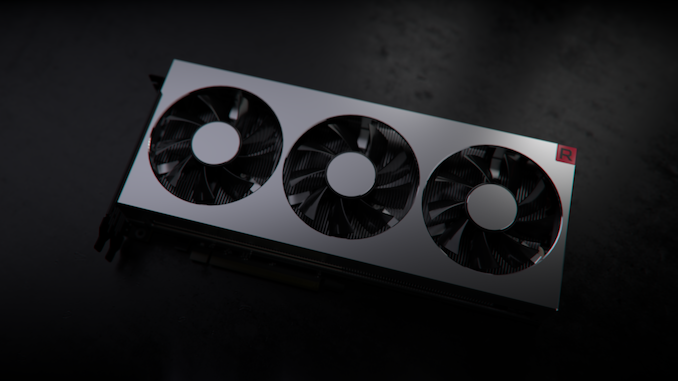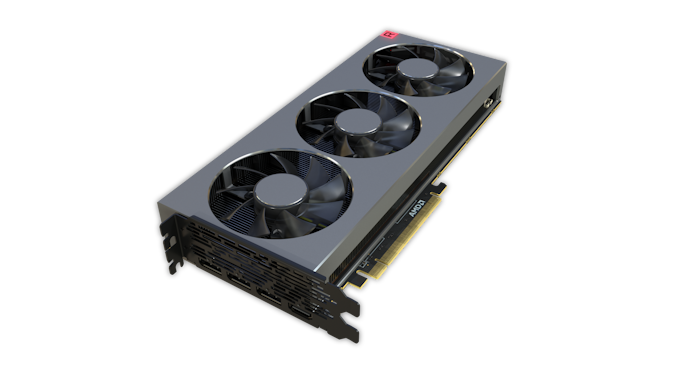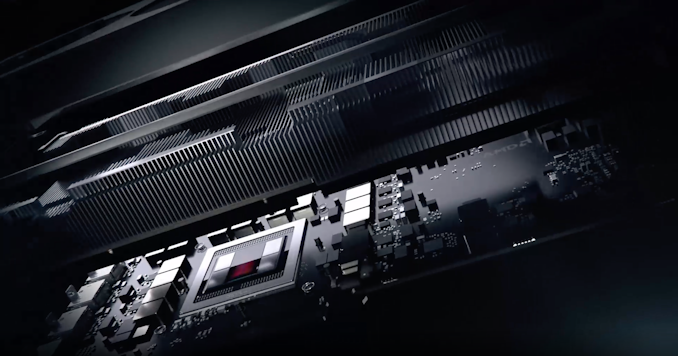The AMD Radeon VII Review: An Unexpected Shot At The High-End
by Nate Oh on February 7, 2019 9:00 AM ESTMeet The Radeon VII
First things first is the design and build, and for the AMD Radeon VII, we've already noticed the biggest change: an open air cooler. Keeping the sleek brushed metal look of the previous RX Vega 64 Limited Edition and Liquid variants, they've forgone the blower for a triple axial fan setup, the standard custom AIB configuration for high-end cards.
While NVIDIA's GeForce RTX series went this way with open-air dual-fan coolers, AMD is no stranger to changing things up themselves. Aside from the RX Vega 64 Liquid, the R9 Fury X's AIO CLC was also quite impressive for a reference design. But as we mentioned with the Founders Edition cards, moving away from blowers for open-air means adopting a cooling configuration that can no longer guarantee complete self-cooling. That is, cooling effectiveness won't be independent of chassis airflow, or lack thereof. This is usually an issue for large OEMs that configure machines assuming blower-style cards, but this is less the case for the highest-end cards, which for pre-builts tend to come from boutique system integrators.
The move to open-air does benefit higher TDP, and at 300W TBP the Radeon VII is indeed one for higher power consumption. While 5W more than the RX Vega 64, there's presumably more localized heat with two more HBM2 stacks, plus the fact that the same amount of power is being consumed but on a smaller die area. And at 300W TBP, this would mean that all power-savings from the smaller process were re-invested into performance. If higher clockspeeds are where the Radeon VII is bringing the majority of its speedup over RX Vega 64, then there would be little alternative to abandoning the blower.
Returning to the Radeon VII build, then, the card naturally has dual 8-pin PCIe connectors, but lacks the BIOS switch of the RX Vega cards that toggled a lower-power BIOS. And with the customary LEDs, the 'Radeon' on the side lights up, as does the 'R' cube in the corner.
In terms of display outputs, there are no surprises here with 3x DisplayPort and 1x HDMI.
A few teardowns of the card elsewhere revealed a vapor chamber configuration with a thermal pad for the TIM, rather than the usual paste. While lower-performing in terms of heat transfer, we know that the RX Vega cards ended up having molded and unmolded package variants, requiring specific instructions to manufacturers on the matter. So this might be a way to head off potential ASIC height difference issues.














289 Comments
View All Comments
just4U - Thursday, February 7, 2019 - link
Really? I see the pre-order pricing here in Canada as 50-100 less then the 2080.Oxford Guy - Thursday, February 7, 2019 - link
I think you missed the noise-to-performance metric.This GPU isn't even close to competitive with the 2080 because of that.
just4U - Friday, February 8, 2019 - link
Sure it is.. a mild undervolt (which the cards support in wattman) is all that's needed. Lower temps lower fan noise. (..shrug)Also since many own blower style cards these 3 fan designs are usually less noise (unless maybe coil whine comes into play..)
Oxford Guy - Friday, February 8, 2019 - link
1) Undervolting is a crap shoot due to binning and other factors, not a solution that you can simply apply as a fix for every one of these cards.2) Saying that some other cards are even louder is a complete avoidance of the issue. The issue is that Nvidia is crushing the noise-to-performance metric with the 2080, according to the presented data in this article. AMD is not, at all, competitive.
eva02langley - Friday, February 8, 2019 - link
Results are there and Vega is greatly improved with undervolting. It is like this since it launch. It is related to the uarch.D. Lister - Friday, February 8, 2019 - link
Which is why I can never recommend AMD GPUs. I mean how competent can they really be if they don't even know how to set proper voltages on their GPUs?Oxford Guy - Friday, February 8, 2019 - link
It's also possible that a GPU will run at a lower voltage that what is optimal without artifacting and yet perform more slowly. Chips are typically able to do some compensation with error correction to handle inadequate voltage but the result is reduced speed.Oxford Guy - Friday, February 8, 2019 - link
You're avoiding the point.eddman - Thursday, February 7, 2019 - link
It's performing better than I expected. It doesn't fully match a 2080 but still performs good enough as a stopgap solution.A bit lower price would've been nice but I suppose it can be justified by the 16GB memory to some extent.
Oxford Guy - Thursday, February 7, 2019 - link
"It doesn't fully match a 2080 but still performs good enough as a stopgap solution."No. It sucks unless you can use the areas of compute it excels at.
There is zero reason to buy a product for gaming that is so much louder for equivalent gaming performance. None.